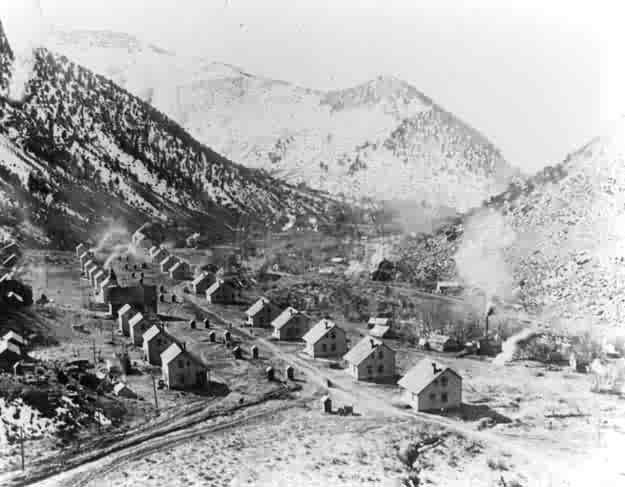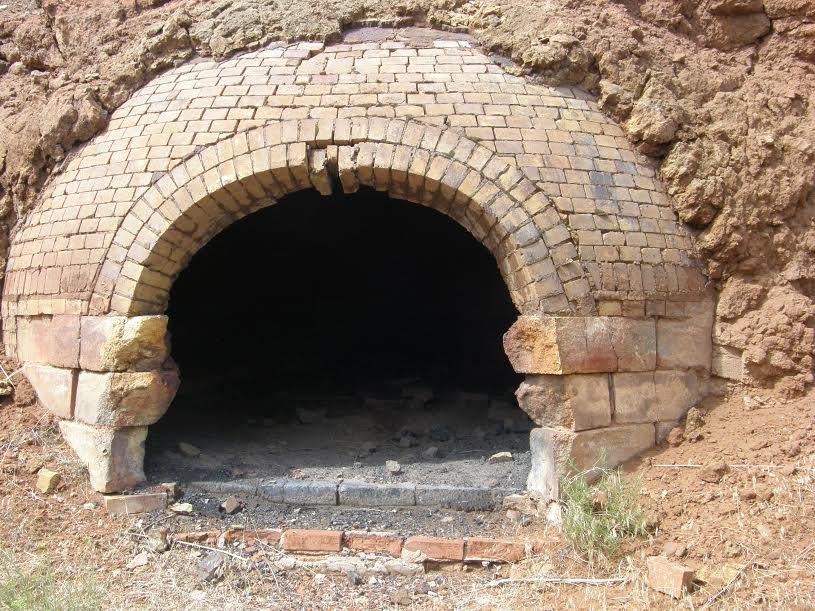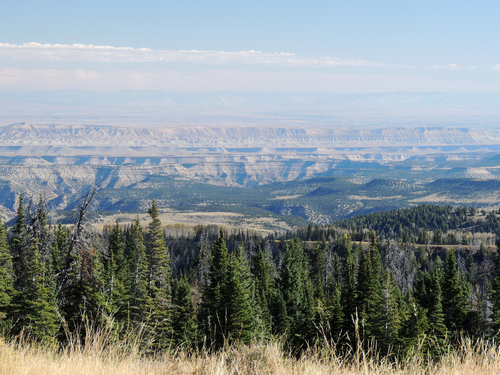You’ve located another stop on the SPX GeoTour. Find them all to earn your prize!
Download the passport here! (starting 6/2/2023)
Sunnyside Coke Ovens

Above: Sunnyside, UT, as seen in the early 1900s.
Coal mining has taken a lot of flack in recent years. It's too dangerous, it's too dirty; we've all heard it, and yes, it can be. But looking back on the coal industry in Carbon County, we really have come a long way. In Sunnyside on the county's eastern border, coke and coal were integral parts of the history and economy. So, you may be asking yourself, "What's coke and where was it made?"
 Now, we are not talking about the bubbly, brown, sugary, carbonated drink that you can get at the local convenient store, which is certainly nice on a hot day; and we definitely don't mean the white, powdery, illicit stuff from the Andean Highlands of South America. What we are talking about is coke, the fuel, as it relates to the coal industry.
Now, we are not talking about the bubbly, brown, sugary, carbonated drink that you can get at the local convenient store, which is certainly nice on a hot day; and we definitely don't mean the white, powdery, illicit stuff from the Andean Highlands of South America. What we are talking about is coke, the fuel, as it relates to the coal industry.
Right: Sunnyside miners, circa 1910s
Coke is coal with all of its volatile properties removed, including water and coal tar. The process to do so produces a coal by-product, coke, which is a hot, stable blast furnace fuel necessary in steel manufacturing.
Good quality coking coal is determined by its moisture, sulfur and ash content. Once baked, it has virtually no moisture remaining and becomes a hard, grey, porous cinder that burns very hot. The remaining impurities baked out are called "slag" or "coke breeze." While slag was initially thought to be a waste product, it soon proved worthwhile in industrial applications, such as brick-making and for lining railroad tracks.
 In 1898, Sunnyside's coal was discovered to be exceptional for coking. Prior to that time, all of the Eastern Utah coke was produced at Castle Gate, which produced inconsistent and often sub-standard results. In 1902, the first coke ovens were built at Sunnyside and the coal shipments to Castle Gate ended by 1905. During 1912 alone, the coke ovens at Sunnyside produced 347,356 tons of coke. To put that into perspective, that's 6,900 coal cars.
In 1898, Sunnyside's coal was discovered to be exceptional for coking. Prior to that time, all of the Eastern Utah coke was produced at Castle Gate, which produced inconsistent and often sub-standard results. In 1902, the first coke ovens were built at Sunnyside and the coal shipments to Castle Gate ended by 1905. During 1912 alone, the coke ovens at Sunnyside produced 347,356 tons of coke. To put that into perspective, that's 6,900 coal cars.
By 1919, Sunnyside had the largest operation of beehive-shaped coke ovens in the United States, 819 ovens by the early 1920s.
Left: Sunnyside Main Street, circa 1920s.
Don't confuse coke ovens with charcoal kilns. While both fuels were used to burn exceptionally hot for the smelting process, the charcoal kilns used wood in generally small scale operations, as they were well-known for terrible environmental impacts, including devastation of forests.

Right: Here is an excellent example of coke ovens that can still be seen today.
The coke ovens were in operation 24 hours a day, 7 days a week. Built with a large hole on top, the coal was dropped into the oven to a depth of between 24 and 36 inches. It was ignited and allowed to bake for up to three days. Once baked, the coke was cooled with water and then removed from the oven by hand with large coking shovels. Finally, the waste material was also removed, the process was repeated. The heat from the initial firing remained and began to bake the coal almost immediately when it entered the ovens. It was a hot and dangerous job and many of the coke oven workers were burned.

Left: Smoke from the coke ovens rises over Sunnyside, c. 1920
The exhaust from the ovens vented directly into the air. On continuous operation, the coke ovens produced a constant plume that hung over the towns of Sunnyside and Dragerton. Laundry hung out to dry was always appeared dirty and gray. At night, the glow from the ovens was spectacular.

Above: Sunnyside miners, 1951. During the 1940s - 50s, Sunnyside saw a brief resurgence of activity & use of the coke ovens.
By the 1930s, the coking operations at Sunnyside had waned. The nationwide demand for coke was falling and only 50 coal cars per year were being shipped from Sunnyside. The coke ovens sat idle. In 1943, shipbuilder Henry J. Kaiser leased the Sunnyside mines and coking operations to provide coke to his steel mill in Fontana, California. Kaiser opened up 297 of the old coke ovens and operated them 24/7 until 1958 when they were permanently closed. Kaiser continued to ship Sunnyside coal to his California operation until 1982.

Above: Some of the original coke ovens, as seen today.
Today, some of the original brick coke ovens remain. To visit, take US Highway 6 east from Price. Turn left at the East Carbon/Sunnyside Junction onto US Highway 123. Entering East Carbon, turn right onto US Highway 124 toward Dragerton. Turn left onto an access road between US Highway 124 and Water Canyon Road. A picnic area and restroom mark the beginning of the trailhead. As always, please visit with respect. These are valuable remains of our past that can never be replaced.
 Note that if you are interested in doing a driving loop from Sunnyside up to 9 Mile Canyon, you can take the Whitmore Canyon Road / aka Water Canyon Rd, and ascend the canyon all the way to Bruin Point. Along they way you'll see suspended ore cars still hanging by cable, perhaps some bighorn sheep, and other relics of the past.
Note that if you are interested in doing a driving loop from Sunnyside up to 9 Mile Canyon, you can take the Whitmore Canyon Road / aka Water Canyon Rd, and ascend the canyon all the way to Bruin Point. Along they way you'll see suspended ore cars still hanging by cable, perhaps some bighorn sheep, and other relics of the past.
Left: Vista as seen from Bruin Point.
Then, you'll arrive at Bruin Point at 10,000 feet elevation, which provides some glorious views of the valley below. After that, you can continue north/ NE and take either the Dry Canyon Rd or Cold Springs / Cottonwood Rd to meet up with Nine Mile Rd, the main paved road that winds through Nine Mile Canyon (a mecca for Native American Petroglyphs). At this point, to head back towards Wellington you would want to turn left / head west, and eventually Nine Mile Rd will return to Wellington to the SW or Duchesne to the North (see this map for more details).
Source: adapted from information provided by the Eastern Utah Tourism and History Association, by josephaw.